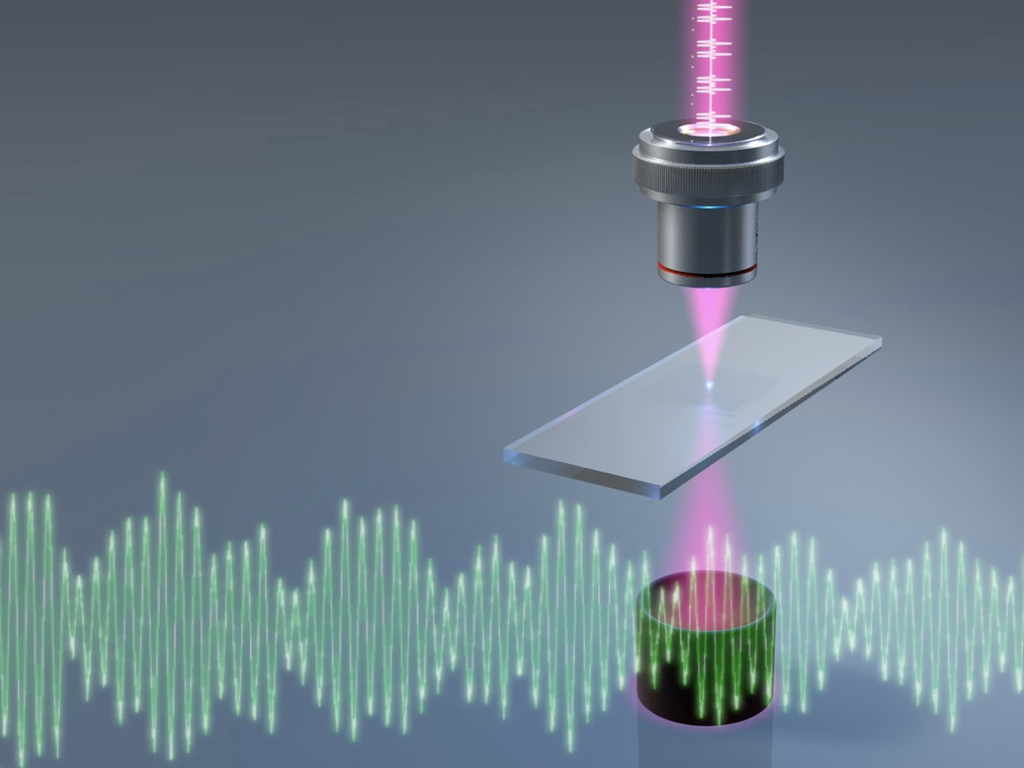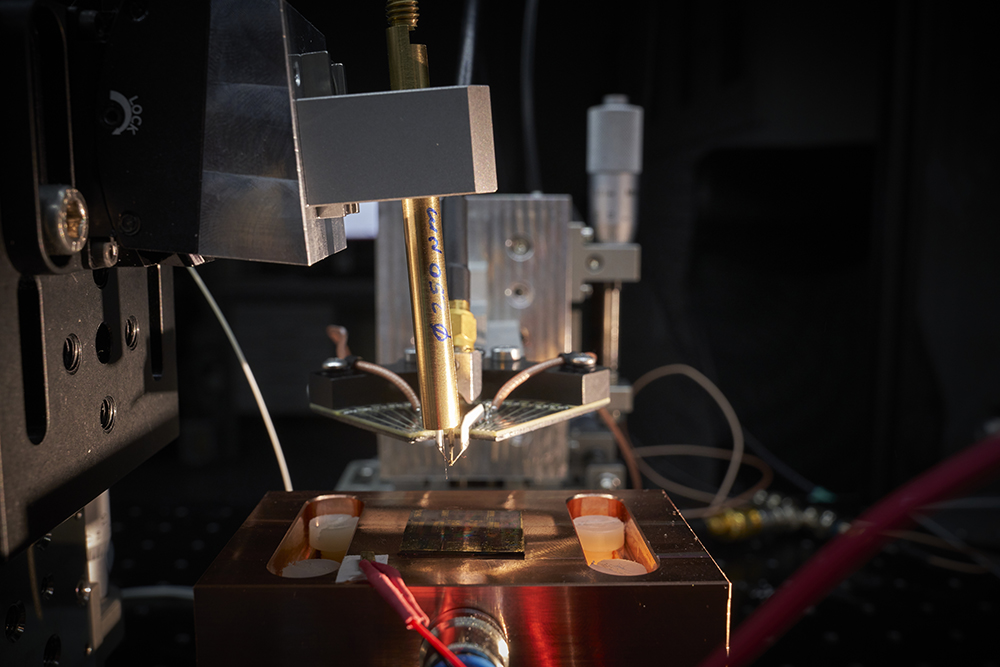Frequency combs, interferometry and spectroscopy
Extending the limits of interferometry
In our group, we conceive new techniques of atomic and molecular spectroscopy using optical frequency combs. We explore new concepts of three-dimensional imaging and dimensional metrology. We harness new approaches to quantum interferometry to gain insight on microscopic samples down to single molecules and nano-particles. We develop novel frequency comb sources using state-of-the-art photonics and laser tools. We perform a variety of experiments in molecular physics with applications that range from precision spectroscopy of small molecules in the gas-phase to biosciences. We analyze our experimental spectra to gain insight on atomic and molecular structure and dynamics. All experiments are table-top and may be operated by one person or a very small team.
Molecules are the building blocks of our world. They are many-body quantum systems and all but the simplest molecules still defy ab-initio calculations. Spectroscopy provides important information about the structure and dynamics of molecules. Sensitive spectroscopic detection of molecules can diagnose diseases and monitor the safety of our environment. Rapid spectral analysis is important for many tasks, from combustion diagnostics to label-free microscopic imaging of selected proteins. Advancing tools of laser science, photonics, opto-electronics, and digital data processing make it possible to invent and explore new approaches to molecular spectroscopy which far exceed existing techniques in speed and sensitivity.
Can we create molecular spectroscopy laboratory on a chip? How can we achieve fast, sensitive spectral acquisition over a broad spectral range? What is the best way to access the mid-infrared molecur fingerprint region? How can we replace optical and mechanical complexity by digital signal processing? What are the ultimate quantum limits? What new insights can we contribute to molecular science?

Dual-comb spectroscopy
The research field of frequency comb spectroscopy, where the frequency comb is used to directly excite or interrogate the sample, has attracted a growing interest in the past five years, mostly for applications to molecular spectroscopy. Dual-comb spectroscopy, that our group has been exploring and perfecting for more than a decade, is emerging as a powerful tool for accurate, fast and sensitive broadband spectroscopy of molecules. Dual-comb spectroscopy is a comb-enabled approach to Fourier transform interferometry without moving parts. In a typical implementation, a frequency comb interrogates the sample and beats on a fast photodiode with a second comb, of slightly different repetition frequency, which acts as a local oscillator. The interference signal is recorded as a function of time and it is Fourier transformed to reveal the spectrum. The photodiode yields a comb of radio-frequency beat notes that can be directly processed by digital electronics. Like common Fourier-transform spectroscopy, dual-comb spectroscopy needs only a single fast photodetector—but it is free from the limitations on recording speed and resolving power imposed by mechanically moving parts. This intriguing instrumental scheme now engages more than fifty research groups and our group collaborates with several of them to share expertise towards the development of new approaches with original comb sources.Precise dual-comb spectroscopy
Dual-comb spectroscopy has faced several challenges. Beyond the obvious but complex requirement of suitable frequency comb synthesizers in the spectral ranges of interest, such as the mid-infrared region where most molecules have strong vibrational fundamental transitions, the two comb sources also must maintain mutual optical phase coherence during data acquisition. Any relative instability makes it impossible to average the interferograms in the detector signal over time—which is necessary to improve the signal-to-noise ratio and thereby to obtain usable spectra even under light-starved conditions. In practice, the goal of mutual coherence is difficult to reach, especially in the mid-infrared region where the laser systems are still often based on nonlinear frequency conversion and are thus more complex.
Our group has developed an experimental approach that has achieved mutual coherence times exceeding 30 minutes in the 1.5-µm and in the 3-µm regions, more than three orders of magnitude longer than that of the state-of-the-art devices in the telecommunication region. The system—which begins with two fiber-laser-based near-infrared frequency combs, with acousto-optic feed-forward servo control to stabilize the combs and with nonlinear difference-frequency generation to produce combs of long mutual coherence times in the 3-µm mid-infrared spectral region—measures mid-infrared high-resolution spectra with excellent consistency over a broad span. Because of the long-lived mutual coherence, time-domain interferograms can be directly summed without corrections, simplifying data acquisition and avoiding artifacts from numerical processing. One key advantage of such a dual-comb system lies in its calibration. The frequency scale here is directly calibrated by an atomic clock, in contrast to approaches such as scanning Fourier transform spectroscopy with incoherent light sources, which must rely on standard lines measured by others. Spectroscopic instruments that measure across broad spectral bandwidths, such as dispersers equipped with a camera or scanning Fourier transform spectrometers, have an instrumental line shape with a width comparable to that of the atomic or molecular transitions being interrogated. Consequently, the retrieval of line parameters requires nonlinear-least-square fitting to account for the convolution by the instrumental line shape, which reduces the precision and accuracy of the results. With our feed-forward dual-comb spectroscopy, employing self-referenced combs, the instrumental line shape is determined by the individual comb lines, and becomes negligible relative to the Doppler-broadened lines of small molecules at room temperature. This significant advance in spectroscopic instrumentation therefore provides a tool that may enable to address new frontiers in precision molecular spectroscopy.
Doppler-free spectroscopy over broad spectral bandwidths
As dual-comb interferometers often harness ultra-short-pulse lasers, they enable novel nonlinear broadband spectroscopy. Our group has pioneered this field with the first applications of dual-comb spectroscopy to nonlinear Raman spectroscopy of samples in the condensed phase. Another interesting domain is that of high-resolution spectroscopy. We have proposed and demonstrated Doppler-free Fourier transform spectroscopy in the gas phase by combining dual-comb spectroscopy and two-photon excitation in a standing-wave field (Fig.6a). The sample is excited by two pairs of counter-propagating pulse trains of slightly different periods in a standing-wave configuration, forming two trains of standing-wave pulses. The upper-state population is modulated as a function of the variable time delay between two pulses from the two asynchronous sources. The modulation period is proportional to the atomic resonance period and can be observed as an intensity modulation in the fluorescence. We have experimentally demonstrated our technique with the two-photon excitation spectrum of the 5S-5D transitions of rubidium vapor around 2×385 THz (2x778 nm). We have recorded (Fig. 6b) Doppler-free two-photon dual-comb spectra of atomic rubidium hyperfine resonances of a width of 6 MHz, while simultaneously interrogating a spectral span of 10 THz with a 1-MHz instrumental resolution. These results extend the range of applications of broadband spectroscopy towards precision nonlinear spectroscopy. Our new technique, which will in the future take advantage of our feed-forward stabilization scheme for long averaging times, may open novel approaches to precision two-photon spectroscopy in the UV or even in the extreme ultraviolet. More generally, the combination of a wide spectral bandwidth and sub-Doppler resolution may enable broadband molecular spectroscopy with unprecedented precision.
